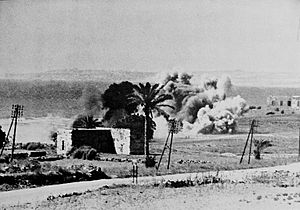Battle of Beirut (1941) facts for kids
Quick facts for kids Battle of Beirut |
|||||||
|---|---|---|---|---|---|---|---|
| Part of the Syria–Lebanon campaign of World War II | |||||||
 Vichy shells explode among the Australians as they advance along the coast road south of Beirut |
|||||||
|
|||||||
| Belligerents | |||||||
|
|
|
||||||
| Commanders and leaders | |||||||
| Strength | |||||||
| 35,000–45,000 90 tanks 120 artillery pieces 30 bombers 60 fighters |
|||||||
The Battle of Beirut happened on 12 July 1941. It was the final event in the Syria–Lebanon campaign during World War II. This battle marked the end of fighting in that region.
Contents
What Was the Syria-Lebanon Campaign?
The Syria-Lebanon campaign was a series of battles in 1941. It was part of World War II. The Allied forces fought against the Vichy French forces. Vichy France was the French government that cooperated with Nazi Germany during the war.
Who Fought in the Campaign?
The Allied side included soldiers from several countries. These were:
- Australia (the Australian 7th Division)
- The United Kingdom (parts of the 1st British Cavalry Division and 6th British Division)
- India (the 5th Indian Infantry Brigade)
- Free France (soldiers loyal to General Charles de Gaulle)
The Vichy French forces were made up of French and Lebanese soldiers. They were led by General Henri Dentz.
Why Did the Battle of Beirut Happen?
The Allies wanted to take control of Syria and Lebanon. They believed these areas could be used by Germany. The Allies launched attacks from different directions. They captured important cities like Damascus. Their rapid advances weakened the Vichy French position.
How the Battle Ended
As Allied troops got closer to Beirut, the Vichy French commander, General Henri Dentz, knew they could not win. He asked for an armistice. An armistice is an agreement to stop fighting.
The fighting officially stopped at one minute past midnight on 12 July 1941. This ended the Syria-Lebanon campaign. An armistice agreement was then signed two days later, on 14 July. This signing took place at the "Sidney Smith Barracks" near the city of Acre.
What Happened After the Battle?
The armistice meant that Syria would now be under the control of the Free French. This was led by General Charles de Gaulle.
The Australian 7th Division marched into Beirut as victors. This successfully established Allied control over Lebanon. Beirut later became a very important base for Allied naval operations in the Mediterranean Sea.

